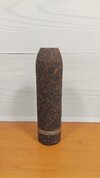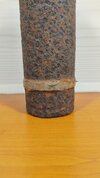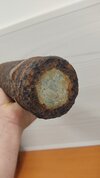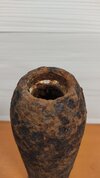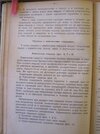Hello everyone,
A few days earlier i have been handed out a large lot of items from a collector that didn`t want them anymore. Some of them are 76,2mm Russian ww1 shells made in France, of various models (there were many variations in respect of fuzes, adaptors, etc.) I suspect one of those was a gas shell and i`m trying to get a confirmation from some more experienced members, as the evidence is a bit contradicting.
1. The shell has at the bottom of the fuze well a white gasket of unknown material (should be lead, but it`s very white and flaky, so it could some kaolin cement), and also the threads are missing the slot for the pin that fixes the fuze adapter. In French 75mm shells this is an indication of a chemical or smoke shell, so I assume it is the same for French-made shells of 76,2mm for Russia.
2. French literature mentions that French shells with liquid contents were made from steel only, therefore they should be without the soldered steel plate on the bottom of the shell, used on lower quality steel. On my shell, this plate is present, as it is on most French-made shells for Russia.
3. The shell is 286mm tall, whereas my other French-made HE shell for Russia is 288mm tall. Despite the 2mm difference in height, they both have the 47mm eye for the fuze.
4. The "gas" shell weighs 5,1kg, whereas the HE shell weighs 5,5kg.
******
Now, my question is if we can determine for sure if this shell had a liquid filling, and if we can exclude the smoke shell. Personally, i have not been able to find references about Russians buying smoke shells from France.
Russian toxic shells were split in three main categories, some of the fillings being described below:
1. Asphyxiating
-chloropicrin with sulfuryl chloride and tin chloride, CCl3NO2 + SO2Cl2 + SnCl2 (marked АЖО/ AZhO on the shell)
-chloropicrin, CCl3NO2 (marked A on the shell)
-chloropicrin with sulfuryl chloride, CCl3NO2 + SO2Cl2 (marked АЖ/AZh on the shell)
2. Poisonous with slow action
3. Poisonous with fast action
-phosgene, COCl2
-phosgene with tin chloride, COCl2 + SnCl2
-vensinite, consisting of either hydrocyanic acid, chloroform, arsenic chloride and tin , or 50% hydrocyanic acid + 50% arsenic trichloride (sources vary)
(i don`t know to which of the slow/fast action categories these fit, feel free to correct me)
A few days earlier i have been handed out a large lot of items from a collector that didn`t want them anymore. Some of them are 76,2mm Russian ww1 shells made in France, of various models (there were many variations in respect of fuzes, adaptors, etc.) I suspect one of those was a gas shell and i`m trying to get a confirmation from some more experienced members, as the evidence is a bit contradicting.
1. The shell has at the bottom of the fuze well a white gasket of unknown material (should be lead, but it`s very white and flaky, so it could some kaolin cement), and also the threads are missing the slot for the pin that fixes the fuze adapter. In French 75mm shells this is an indication of a chemical or smoke shell, so I assume it is the same for French-made shells of 76,2mm for Russia.
2. French literature mentions that French shells with liquid contents were made from steel only, therefore they should be without the soldered steel plate on the bottom of the shell, used on lower quality steel. On my shell, this plate is present, as it is on most French-made shells for Russia.
3. The shell is 286mm tall, whereas my other French-made HE shell for Russia is 288mm tall. Despite the 2mm difference in height, they both have the 47mm eye for the fuze.
4. The "gas" shell weighs 5,1kg, whereas the HE shell weighs 5,5kg.
******
Now, my question is if we can determine for sure if this shell had a liquid filling, and if we can exclude the smoke shell. Personally, i have not been able to find references about Russians buying smoke shells from France.
Russian toxic shells were split in three main categories, some of the fillings being described below:
1. Asphyxiating
-chloropicrin with sulfuryl chloride and tin chloride, CCl3NO2 + SO2Cl2 + SnCl2 (marked АЖО/ AZhO on the shell)
-chloropicrin, CCl3NO2 (marked A on the shell)
-chloropicrin with sulfuryl chloride, CCl3NO2 + SO2Cl2 (marked АЖ/AZh on the shell)
2. Poisonous with slow action
3. Poisonous with fast action
-phosgene, COCl2
-phosgene with tin chloride, COCl2 + SnCl2
-vensinite, consisting of either hydrocyanic acid, chloroform, arsenic chloride and tin , or 50% hydrocyanic acid + 50% arsenic trichloride (sources vary)
(i don`t know to which of the slow/fast action categories these fit, feel free to correct me)

